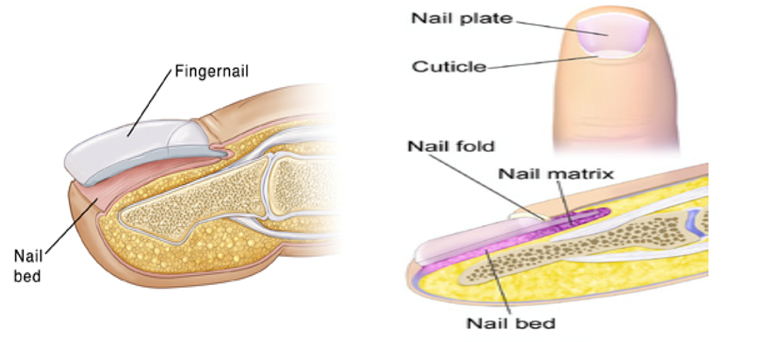How to Care for Your Child after a Nail Bed Laceration (Cut) Repair
This leaflet will provide you with information about nail bed injury causes, treatment and home care advices.

What is nail bed injury?
A nail bed injury is a very common childhood injury which happens when a fingertip or toe gets crushed or trapped between or by a heavy object, such as being shut in a closing door.
The nail bed sits between the fingernail or toenail and the bone. It helps the nail grow normally and protects the nail plate to the fingertip or toe. Even if there is no clear damage to the nail there could be damage to the nail bed underneath. Unrepaired damage at the nail bed could cause the nail to grow with ridges or be misshaped.
Some cases may be associated with a fracture of the distal phalanx (the fingertip bones), which is called a tuft fracture. This means that small fragments have chipped off the edge of the bone. A nail bed and soft tissue repair is usually sufficient in treating this fracture and it usually heal by itself.
How is nail bed injury treated?
- Your child will have a short operation to repair the nail bed
- Your child’s healthcare provider will have your child’s nail partially or fully removed, and the area will be cleaned
- Your child’s healthcare provider will repair your child’s nail bed as well as any tearing of soft tissue using fine dissolvable stitches
- Your child’s healthcare provider will cover the treated area with a sterile dressing
Home care advice
It is important that you encourage your child to:
- Rest and keep the injured part raised to reduce swelling and pain for the first two days
- Take painkillers as prescribed and advised by the doctor
- Avoid activities involving sand and grit or where the wound could get knocked or banged
- Keep the wound and dressing dry and as clean as possible until the follow-up appointment
- Leave the dressing and, the finger splint (if your child has one) in place until the follow-up visit
- Ensure your child tetanus immunization is up to date
Follow-up appointment…
- Your child will come for a follow up within five days to have their dressing removed and their wound checked.
- Further follow up depends on your child’s condition on first visit
- After the first follow up appointment your child’s finger or toe may still look swollen and have some dried blood around the end after the dressing is removed. The nail bed and fingertip or toe may also look a bit lumpy. This is normal and nothing to worry about
- In some cases, the stitched skin may not survive but it will serve as a natural dressing and finally fall off. Blood may continue to come from under the nail for one to two days
- Sometimes if the nailbed had been very damaged the nail may not grow properly despite the repair to the fingertip
Go to the Emergency Department if:
- The dressing is very dirty
- The wound is bleeding
- The bandage is slipping off, do not pull it back up,
- Your child:
- Has increased pain
- Feels unwell
- Has a bad smell or redness under the dressing

